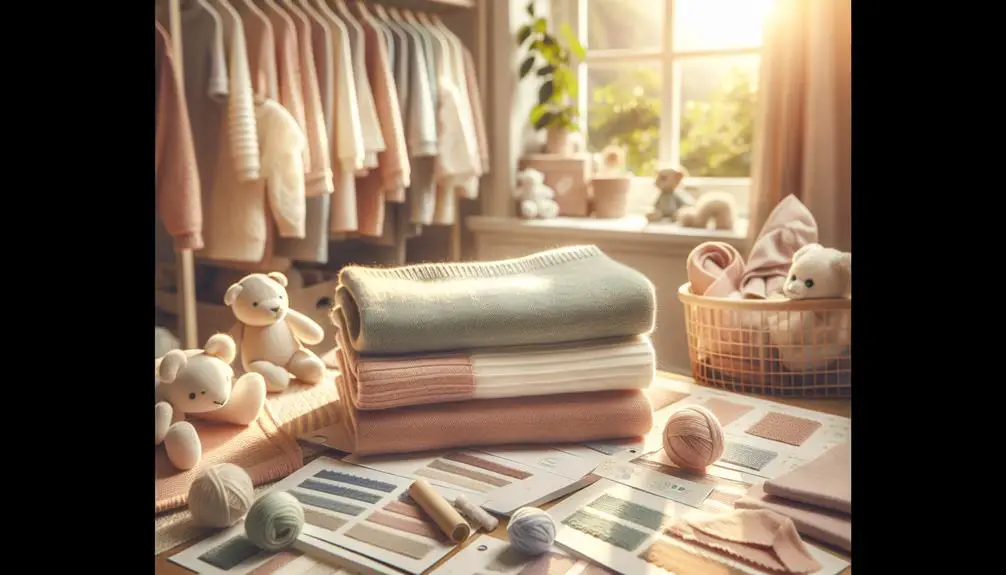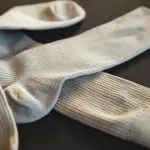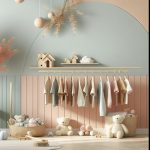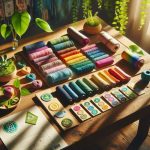Selecting the ideal fabric for your baby's clothes can feel like finding your way through a maze of endless options. You're not just searching for something adorable; you want materials that are safe and cozy for your little one. Hypoallergenic fabrics such as organic cotton, bamboo, and silk are superb choices to reduce skin irritations. But how do you guarantee the fabric meets strict safety standards? Certifications like OEKO-TEX Standard 100 or GOTS can serve as your guide. Curious to understand why these certifications are important and which fabrics encourage a more wholesome environment for your baby?
Table of Contents
Key Takeaways
- Choose organic cotton for its hypoallergenic, breathable, and gentle properties on baby skin.
- Verify fabric certifications like OEKO-TEX Standard 100 and GOTS for safety and non-toxic assurance.
- Opt for bamboo and hemp fabrics for their moisture-wicking and temperature-regulating capabilities.
- Avoid synthetic fibers like polyester that trap heat and moisture, causing potential irritation.
- Select durable, easy-care fabrics like organic cotton and bamboo for longevity and simplified maintenance.
Understanding Fabric Types
When selecting baby garments, comprehending the various kinds of fabrics is crucial for guaranteeing your little one's comfort and safety. Grasping fabric characteristics aids in choosing materials that are gentle, breathable, and kind to your baby's delicate skin. Cotton, for instance, is hypoallergenic and exceptionally absorbent, making it a top pick for baby clothing. Its breathability assures your baby remains cool, while its gentleness prevents any skin irritation.
Fabric maintenance is another vital aspect. Cotton is simple to launder and endures frequent washing without compromising its shape or softness. Conversely, artificial fabrics like polyester may be more resilient but have the potential to trap heat and moisture, resulting in discomfort and possible skin issues. When evaluating fabric characteristics, you should seek materials that are machine washable and retain their excellence after numerous washes.
Bamboo fabric is another superb choice, recognized for its antibacterial characteristics and extraordinary softness. It's also highly absorbent and breathable, offering a cozy experience for your baby.
Understanding these fabric traits empowers you to make educated decisions, ensuring your baby's garments are both pleasant and simple to maintain.
Importance of Organic Materials
Selecting organic materials for baby clothes guarantees a safer and more sustainable option for your little one. When you choose organic fabrics, you're opting for materials produced without synthetic pesticides or harmful chemicals. This not only ensures your baby's delicate skin is free from irritants but also supports better soil health. Organic farming practices focus on maintaining and enhancing soil quality through natural means, which promotes a healthier ecosystem overall.
From an environmental perspective, organic materials notably reduce the negative impact on our planet. Conventional farming methods often rely on chemical fertilizers and pesticides, which can contaminate water sources and degrade soil over time. By choosing organic cotton or bamboo, for instance, you're contributing to a more sustainable agricultural system that prioritizes environmental health.
Furthermore, the production of organic fabrics often requires less water and energy compared to non-organic counterparts. This reduction in resource consumption makes a significant difference in mitigating the environmental impact.
Breathability and Comfort
In addition to selecting organic materials, emphasizing breathability and comfort guarantees your baby remains cool and comfortable throughout the day. Breathable fabrics, like cotton and bamboo, ensure proper air circulation, preventing overheating and allowing your baby's skin to breathe.
These materials excel at temperature regulation, keeping your little one cozy in cooler weather and cool during warmer months.
Moisture-wicking properties are vital in baby clothes, as they draw sweat away from the skin, preventing irritation and rashes. Opt for fabrics that combine breathability with moisture-wicking capabilities to maintain a dry and comfortable environment for your baby.
The softness of the fabric is equally important. Babies have delicate skin that needs gentle, skin-friendly materials to avoid friction and discomfort.
When selecting fabrics, prioritize those recognized for their skin-friendly nature. Cotton, for example, is renowned for its softness and hypoallergenic properties, making it an excellent choice for baby clothes.
Bamboo fabric also offers superior softness and is naturally moisture-wicking and thermoregulating, providing a perfect balance of comfort and functionality.
Avoiding Harmful Chemicals
When choosing baby clothes, you should prioritize natural fibers like cotton and bamboo to avoid harmful chemicals.
Look for certified organic labels, which guarantee the fabric hasn't been treated with toxic substances.
This simple step can help protect your baby's sensitive skin from irritation and allergies.
Natural Fiber Preferences
Opt for natural fibers like organic cotton and bamboo to keep harmful chemicals away from your baby's delicate skin. Unlike synthetic fibers, which often contain harmful chemicals, natural fibers provide a safer alternative.
Synthetic fiber drawbacks include potential skin irritation and a significant environmental impact due to their non-biodegradable nature and the pollutants released during their production.
Natural fibers not only prioritize your baby's health but also align with sustainable fashion principles. By choosing eco-friendly options, you're contributing to a healthier planet.
Here's why natural fibers should be your go-to:
- Breathability: Organic cotton and bamboo allow your baby's skin to breathe, reducing the risk of rashes and discomfort.
- Softness: These materials are naturally soft, ensuring your baby feels cozy and comfortable.
- Hypoallergenic: They're less likely to cause allergic reactions, making them ideal for sensitive skin.
- Biodegradability: Natural fibers break down more easily, minimizing their environmental footprint.
Certified Organic Labels
Look for certified organic labels to safeguard your baby's clothes are free from harmful chemicals. These labels guarantee that the fabrics have been produced using eco-friendly alternatives that aren't only safe for your little one but also promote sustainable fashion.
Organic certification means the materials were grown without synthetic pesticides, herbicides, or fertilizers, reducing the risk of irritation or allergies for your baby.
By choosing certified organic fabrics, you're also opting for biodegradable options that lessen the environmental impact.
Conventional cotton, for instance, often involves heavy chemical use and contributes to soil degradation and water pollution. Organic cotton, on the other hand, maintains soil health and utilizes water more efficiently.
When you select baby clothes with these labels, you're supporting a system that's better for the planet and future generations.
Certified organic labels like GOTS (Global Organic Textile Standard) and OEKO-TEX Standard 100 give you the confidence that the entire production process—from raw materials to finished product—meets strict environmental and social criteria.
In doing so, you're not just making a safer choice for your baby, but also advocating for a healthier, more sustainable world.
Hypoallergenic Options
Many parents seek hypoallergenic fabrics to safeguard their baby's sensitive skin from irritation. When selecting materials, you'll want to contemplate sensory friendly options and chemical free alternatives. These fabrics guarantee your baby's comfort and minimize the risk of allergic reactions.
To assist you in making informed choices, here's a list of hypoallergenic fabrics worth pondering:
- Organic Cotton: Free from pesticides and synthetic chemicals, organic cotton is incredibly gentle on the skin and highly breathable.
- Bamboo Viscose: Known for its natural hypoallergenic properties, bamboo viscose is soft, moisture-wicking, and ideal for sensitive skin.
- Hemp: This eco-friendly fabric is naturally resistant to mold and UV rays. It's also highly durable and becomes softer with every wash.
- Silk: Luxuriously smooth and hypoallergenic, silk can regulate temperature and is perfect for delicate skin.
Checking Fabric Certifications
When selecting fabrics for baby clothes, you'll want to make sure they meet recognized safety standards.
Look for organic certification labels to confirm the absence of harmful chemicals.
Also, verify that the dyes used are non-toxic to keep your little one safe.
Recognized Safety Standards
How do you guarantee the fabrics for your baby's clothes meet recognized safety standards?
First, familiarize yourself with the necessary safety regulations and fabric testing methods. These confirm that the fabric is free from harmful chemicals and safe for your baby's sensitive skin. Adhering to these standards is essential for your peace of mind.
Next, look for certifications that indicate rigorous quality control and adherence to industry standards. Recognized certifications are evidence that the fabric has undergone thorough testing and meets the safety requirements set by regulatory bodies.
Here are some key certifications to look for:
- OEKO-TEX Standard 100: Confirms fabrics are free from harmful substances.
- Global Organic Textile Standard (GOTS): Focuses on organic fibers and sustainable manufacturing.
- Blue Sign: Certifies that the fabric meets environmental and safety standards.
- ASTM International: Provides global standards for material safety and performance.
These certifications serve as a reliable indicator of quality and safety, helping you make informed decisions when selecting fabrics for your baby. By prioritizing certified fabrics, you're not just following industry standards but securing your baby's comfort and well-being.
Organic Certification Labels
To confirm the fabrics you choose for your baby's clothes are truly organic, check for reputable certification labels. Look for labels such as GOTS (Global Organic Textile Standard) and OEKO-TEX Standard 100. These certifications confirm the fabrics meet stringent criteria for organic content and sustainability practices. GOTS, for example, requires that textiles contain at least 70% organic fibers and adhere to eco-friendly manufacturing processes.
When you see these labels, you can be confident that the materials were produced with ethical sourcing and fair trade certifications in mind. This means the workers involved in the production process were treated fairly and compensated justly, supporting their well-being and communities.
Additionally, these certifications often mandate adherence to strict environmental standards, reducing the overall impact on our planet.
Non-Toxic Dye Verification
Verifying your baby's clothes are free from harmful chemicals involves checking for certifications that confirm the use of non-toxic dyes. These certifications provide peace of mind, knowing that the fabrics have undergone rigorous toxicity testing to guarantee they're safe for your little one.
Here's how you can confidently confirm non-toxic dye claims.
Look for certifications like:
- OEKO-TEX Standard 100: This certifies that the fabric has been tested for over 100 harmful substances.
- GOTS (Global Organic Textile Standard): Not only does it ensure organic fabric, but it also mandates the use of eco-friendly alternatives in dyes.
- Bluesign: This certification focuses on sustainable textile production, ensuring the safety of dyes and reducing environmental impact.
- Greenguard: This certifies products for low chemical emissions, contributing to healthier indoor environments.
Don't just trust labels at face value. Explore the details of each certification. Confirm that the brand or manufacturer has consistently passed toxicity testing. Reach out to customer service if necessary to ask for documentation or further information on the dyes used.
Durability and Longevity
When selecting baby clothes, you should consider fabrics that withstand frequent washing and wear without losing their shape or softness. Ensuring durability and longevity in baby clothing begins with smart material selection. Natural fibers like organic cotton, bamboo, and merino wool aren't only gentle on your baby's skin but also resilient. These materials maintain their integrity through numerous washes, making them ideal for daily use.
Fabric care plays a vital role in extending the life of baby clothes. Opt for fabrics that don't require harsh detergents or special handling. For example, pre-shrunk cotton and durable blends are easier to care for and less likely to shrink or pill over time. This allows you to keep the clothes looking new, even after countless wears and washes.
Moreover, pay attention to construction details like reinforced seams and quality stitching. These elements can greatly enhance the garment's durability. Well-made clothes are less likely to develop holes or fray at the edges, ensuring they last longer.
Easy Care Fabrics
While durable fabrics are important, you'll also want to choose easy care fabrics that simplify your laundry routine. When it comes to baby clothes, ease of care can make a significant difference in managing your time and ensuring your little one always has clean, fresh outfits.
Consider the following easy care fabric qualities:
- Stain resistant options: Babies are known for spills and messes. Fabrics treated to resist stains can save you countless hours of scrubbing and soaking.
- Quick drying materials: Quick drying materials like certain cotton blends or microfiber are a lifesaver when you need clean clothes in a hurry.
- Eco friendly selections: Opt for organic cotton or bamboo, which aren't only gentle on your baby's skin but also better for the planet.
- Sustainable choices: Look for fabrics produced using sustainable practices to support environmental conservation while maintaining quality and ease of care.
Budget-Friendly Choices
Finding budget-friendly fabrics for baby clothes doesn't mean you have to compromise on quality or safety. One excellent approach is exploring secondhand options. Many thrift stores and online marketplaces offer gently used baby clothes made from high-quality, safe fabrics. Pre-owned garments often come at a fraction of the cost, providing you with the opportunity to dress your baby in soft, comfortable clothing without breaking the bank. Always make sure that these items are thoroughly washed and checked for any wear and tear before use.
Another strategy is considering DIY alternatives. If you have basic sewing skills, purchasing fabric remnants or bulk organic cotton can be a cost-effective way to create custom baby clothes. Homemade items not only give you control over the fabric's quality but also allow for personalized designs and fits. Plus, sewing your own baby clothes can be a rewarding and creative hobby.
Don't overlook fabric sales and coupons at local craft stores. Keeping an eye out for discounts can significantly decrease your costs. By combining secondhand options and DIY alternatives, you can provide your baby with safe, comfortable clothing without exceeding your budget.
Frequently Asked Questions
How Do I Determine the Right Size for Baby Clothes?
Determining the correct size for baby clothes can feel like solving a million-piece puzzle! Measure accurately, but remember babies are growing rapidly. Sizing up and buying ahead guarantees they'll have room to grow.
What Are the Best Seasons for Different Fabric Types?
You'll want to prioritize fabric durability and seasonal considerations. For summer, choose breathable fabrics like cotton for higher comfort levels. In winter, opt for warmer, durable fabrics like wool to maintain cozy warmth.
How Often Should Baby Clothes Be Replaced for Safety?
Picture your baby snuggled in a cozy onesie. You should replace baby clothes when you see signs of wear like frayed edges and thinning fabric. Recycling vs. replacing depends on the garment's condition and safety.
Can I Mix Different Fabric Types in One Outfit?
You can mix different fabric types in one outfit, but guarantee fabric compatibility for outfit safety. Pay attention to fabric care instructions when mixing materials to prevent damage. This will help maintain the outfit's longevity and safety.
Are Certain Colors Safer for Baby Clothes?
Did you know 60% of fabric dyes contain harmful chemicals? When selecting colors for baby clothes, consider color toxicity and fabric dye effects. Opt for natural dyes to guarantee your baby's safety and avoid potential skin irritations.
- How Does Ring Spun Cotton Affect Garment Fit and Shape Retention? - August 13, 2024
- What Are the Challenges in Producing Ring Spun Cotton? - August 13, 2024
- Is Ring Spun Cotton Suitable for Plus-Size Clothing? - August 13, 2024







